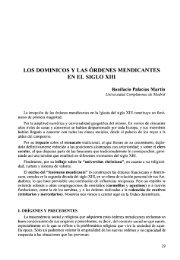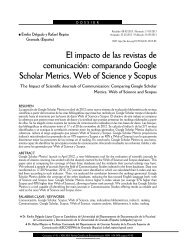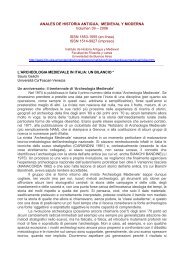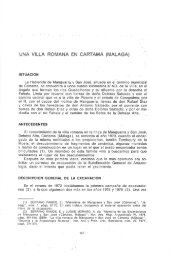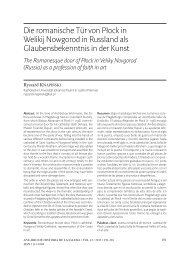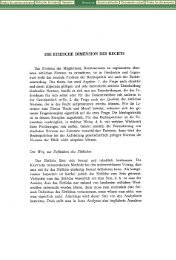Roslyn M. Frank 1.0. Introduction In the first chapter of this ... - Dialnet
Roslyn M. Frank 1.0. Introduction In the first chapter of this ... - Dialnet
Roslyn M. Frank 1.0. Introduction In the first chapter of this ... - Dialnet
You also want an ePaper? Increase the reach of your titles
YUMPU automatically turns print PDFs into web optimized ePapers that Google loves.
98 <strong>Roslyn</strong> M. <strong>Frank</strong><br />
2.1. Paleolithic Continuity (PC): A third narrative<br />
The possibility that <strong>the</strong> two narratives are more interwoven than <strong>the</strong>y might<br />
appear at <strong>first</strong> glance is highlighted by <strong>the</strong> fact that <strong>the</strong>re is a third competing<br />
narrative that emphasizes <strong>the</strong> contributions <strong>of</strong> hunter-ga<strong>the</strong>rers to <strong>the</strong> linguistic<br />
landscape <strong>of</strong> prehistoric Europe. Here I am referring to <strong>the</strong> work <strong>of</strong> <strong>the</strong> Italian<br />
linguist Mario Alinei and his colleagues, members <strong>of</strong> <strong>the</strong> Working Group on<br />
Palaeolithic Continuity <strong>the</strong>ory (Alinei 2004a, b, 2006; Costa 2001, 2004). First,<br />
I would note that <strong>the</strong> position endorsed by <strong>the</strong>se researchers does not take into<br />
consideration <strong>the</strong> possible linguistic and cultural significance <strong>of</strong> <strong>the</strong> western<br />
Pyrenean-Cantabrian refugium for <strong>the</strong>ir model. Ra<strong>the</strong>r <strong>the</strong>y address <strong>the</strong> need to<br />
assign a far greater time-depth to IE languages and in <strong>the</strong> process <strong>the</strong>y establish<br />
a narrative that calls for a much more in situ explanatory framework for <strong>the</strong><br />
development <strong>of</strong> IE languages, as opposed to one that relies solely on demic and/<br />
or cultural diffusion, such as is <strong>the</strong> case with Renfrew’s model.<br />
<strong>In</strong> <strong>this</strong> respect, I would emphasize, along with Richards, that in <strong>the</strong> past «<strong>the</strong><br />
assumed model <strong>of</strong> surplus-driven population growth and expansion led both<br />
groups [<strong>of</strong> researchers, geneticists and archaeologists alike] to tend to play up<br />
<strong>the</strong> role <strong>of</strong> <strong>the</strong> Neolithic newcomers at <strong>the</strong> expense <strong>of</strong> <strong>the</strong> indigenous Mesolithic<br />
peoples. After all, it was <strong>the</strong> newcomers who had won in <strong>the</strong> end» and that at<br />
«<strong>the</strong> deepest level, as Zvelebil (1996) argues, <strong>this</strong> amounted to a founding myth<br />
for European culture and civilization that placed extraordinary emphasis on <strong>the</strong><br />
Neolithic – a myth that idolizes farmers at <strong>the</strong> expense <strong>of</strong> hunting and foraging<br />
ways <strong>of</strong> life» (Richards 2003: 135).<br />
After reviewing criticisms that have been leveled at Renfrew’s Anatolian<br />
<strong>the</strong>ory, e.g., in terms <strong>of</strong> <strong>the</strong> over emphasis on <strong>the</strong> Neolithic transition in Europe<br />
(Alinei 2004b; Costa 2001; Zvelebil 1995a, b, 1996, 2002; Zvelebil and Zvelebil<br />
1988, 1990), Alinei, one <strong>of</strong> <strong>the</strong> leading proponents <strong>of</strong> <strong>the</strong> Teoria della Continuità,<br />
makes <strong>the</strong> following observations:<br />
Su questa base due archeologi (Häusler 1998; Otte 1994, 1995) e un linguista<br />
(Alinei 1997, 2000), tutti e tre l’uno indipendentemente dall’altro, hanno<br />
propost un’altra teoria delle origini IE, secondo la quale gli <strong>In</strong>doeuroepei non<br />
sarebbero arrivati né dall’Ucraina come guerrieri né come coltivatori dal Medio<br />
Oriente, ma sarebbero gli eredi delle popolazioni che si trovano in Europa da<br />
sempre, cioé da quando, nel Paleolitico Medio, Homo sapiens sapiens, provenendo<br />
dall’Africa, si è diffuso nei vari continenti, del Vecchio Mundo. [‘On <strong>this</strong><br />
basis two archaeologists (Häusler 1998; Otte 1994, 1995) and a linguist (Alinei<br />
1997, 2000), all three independently <strong>of</strong> <strong>the</strong> o<strong>the</strong>r, have proposed ano<strong>the</strong>r <strong>the</strong>ory<br />
<strong>of</strong> IE origins, according to which <strong>the</strong> <strong>In</strong>do-Europeans would not have arrived<br />
from <strong>the</strong> Ukraine as warriors or as farmers from <strong>the</strong> Middle East, ra<strong>the</strong>r <strong>the</strong>y



